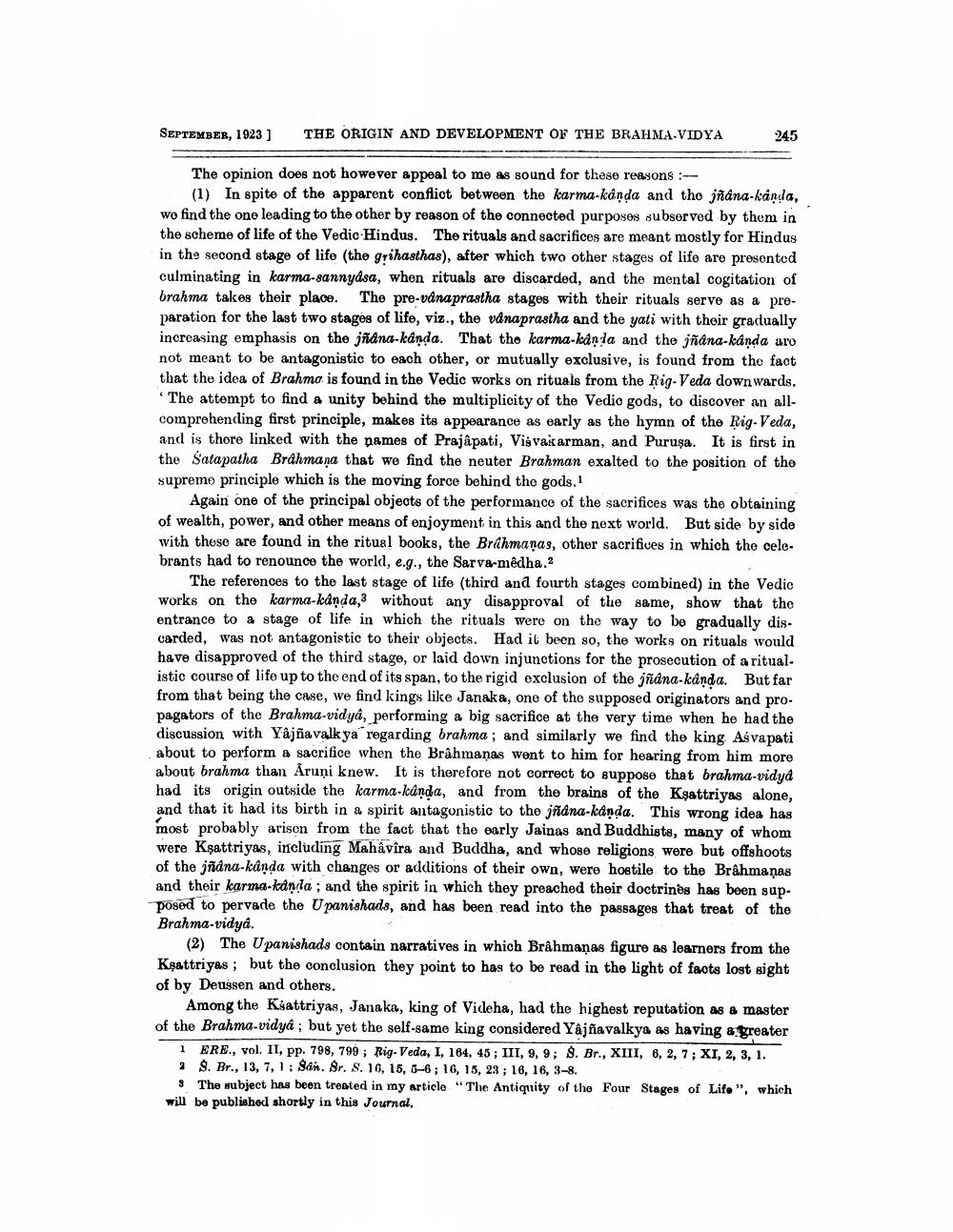________________
SEPTEMBER, 1923 ]
THE ORIGIN AND DEVELOPMENT OF THE BRAHMA VIDYA
245
The opinion does not however appeal to me as sound for these reasons :
(1) In spite of the apparent conflict between the karma-kanda and the jñana-kanda, wo find the one leading to the other by reason of the connected purposes subserved by them in the scheme of life of the Vedic Hindus. The rituals and sacrifices are meant mostly for Hindus in the second stage of life (the grihasthas), after which two other stages of life are presented culminating in karma-sannyása, when rituals are discarded, and the mental cogitation of brahma takes their place. The pre-vanaprastha stages with their rituals serve as a preparation for the last two stages of life, viz., the vanaprastha and the yati with their gradually increasing emphasis on the jñana-kânda. That the karma-kânda and the jñana-kânda aro not meant to be antagonistic to each other, or mutually exclusive, is found from the fact that the idea of Brahma is found in the Vedic works on rituals from the Rig Veda downwards.
The attempt to find a unity behind the multiplicity of the Vedio gods, to discover an allcomprehending first principle, makes its appearance as early as the hymn of the Rig Veda, and is there linked with the names of Prajapati, Vigvakarman, and Puruşa. It is first in the Satapatha Brahmana that we find the neuter Brahman exalted to the position of the supremo principle which is the moving force behind the gods. 1
Again one of the principal objects of the performance of the sacrifices was the obtaining of wealth, power, and other means of enjoyment in this and the next world. But side by side with these are found in the ritual books, the Brahmanas, other sacrifices in which the celebrants had to renounce the world, e.g., the Sarva-mêdha.
The references to the last stage of life (third and fourth stages combined) in the Vedio works on the karma-kända, without any disapproval of the same, show that the entrance to a stage of life in which the rituals were on the way to be gradually dis. carded, was not antagonistic to their objects. Had it been so, the works on rituals would have disapproved of the third stage, or laid down injunctions for the prosecution of a ritual. istic course of life up to the end of its span, to the rigid exclusion of the jñana-kanda. But far from that being the case, we find kings like Janaka, one of the supposed originators and propagators of the Brahma-vidya, performing a big sacrifice at the very time when he had the discussion with Yajnavalk ya regarding brahma; and similarly we find the king Asvapati about to perform a sacrifice when the Brahmanas went to him for hearing from him more about brahma than Aruni knew. It is therefore not correct to suppose that brahma-vidyd had its origin outside the karma-kûnda, and from the brains of the Kşattriyas alone, and that it had its birth in a spirit antagonistic to the jñidna-kanda. This wrong idea has most probably arison from the fact that the early Jainas and Buddhists, many of whom were Knattriyas, including Mahavira and Buddha, and whose religions were but offshoots of the iñana-kânda with changes or additions of their own, were hostile to the Brâhmanas and their karma-kanda ; and the spirit in which they preached their doctrines has been sup. posed to pervade the Upanishads, and has been read into the passages that treat of the Brahma-vidya.
(2) The Upanishads contain narratives in which Brahmaņas figure as learners from the Kşattriyas; but the conclusion they point to has to be read in the light of faots lost sight of by Deussen and others.
Among the Ksattriyas, Janaka, king of Videha, had the highest reputation as a master of the Brahma-vidya ; but yet the self-same king considered Yâjsavalkya as having a greater
1 ERE., vol. II, pp. 798, 799; Rig Veda, I, 164, 45; III, 9, 9; 9. Br., XIII, 6, 2, 7; XI, 2, 3, 1. 1 9. Br., 13, 7, 1: San. Sr. S. 16, 15, 0-6; 16, 15, 23; 16, 16, 3-8.
3 The subject has been treated in my article "The Antiquity of the Four Stages of Life", which will be published shortly in this Journal,




